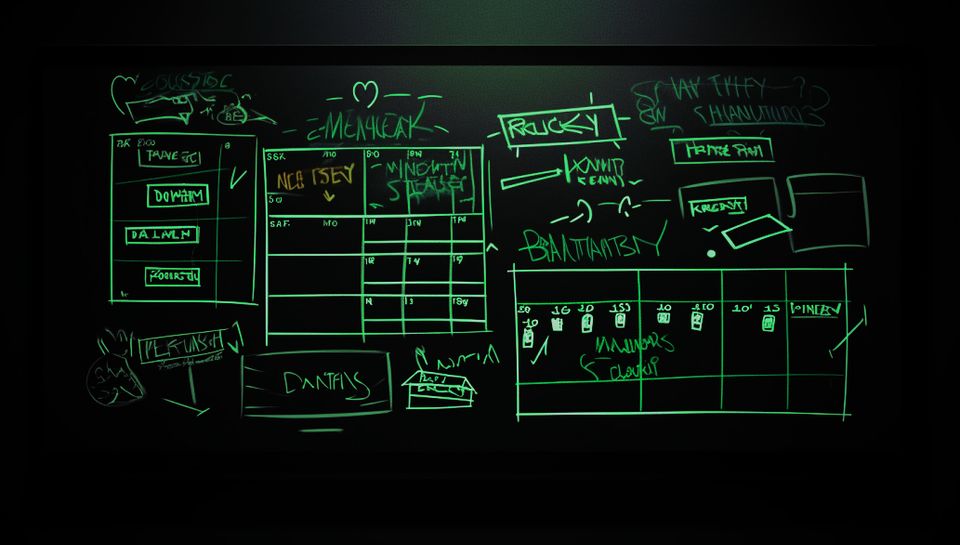One Year Plan

In the realm of entrepreneurship, aiming to create a Micro SaaS MVP that generates a steady income within a year is a commendable goal. This is achievable as long as you steer clear of common mistakes made in initial attempts.
Your first failure doesn't make you immune.
Now, let's explore the common challenges of building a marketable small to medium-scale service. We'll draw from personal experiences and data-backed insights to dissect the essential elements of this journey.
Individuals with strong technical backgrounds, such as software engineers, often exhibit specific traits when venturing into the world of business. These traits, including introversion and a tendency to rely on intuition over business knowledge, were qualities I recognized in my own past self. I used to find joy in the lab, creating things on my computer but rarely explored the sales and business side of things.
Establishing a Viable Micro SaaS MVP
Our journey commences with a clear goal: to establish a Minimum Viable Product (MVP) in the Micro SaaS domain that ensures sustainable income within a year.
It's an ambitious mission and one that demands a strategic approach.
Common Pitfalls and Challenges
When delving into the online business world, many newcomers encounter common challenges.
Lack of Market Research
Initially, unwavering confidence in their concepts may lead individuals to disregard the critical step of market research. This can happen when one is convinced of having a groundbreaking idea and relies heavily on intuition. In many cases, like that of someone deeply involved in coding and tech news, there's limited exposure to the real needs, problems, and dynamics of the specific niche they aim to enter. Intuition, though powerful, can often prove misleading in the absence of real-world contact with experts or stakeholders in the field.
Technical Overindulgence
Many tech enthusiasts share a deep-seated belief in the 'build it, and they will come' philosophy, despite the spoiler alert being a resounding 'No, they won't.'
They often become fixated on fine-tuning every technical aspect, obsessing over the ideal tech stack for each layer of the application. This relentless pursuit of scalability, envisioning it to accommodate millions of future users, unfolds in isolation from any idea validation or market research.
Tech Isn't Everything
While the idea held intrigue and boasted impeccable technical implementation, it tackled a non-existent real-world problem. To compound matters, even if the solution was spot-on, there was a lack of marketing savvy, a network to champion the concept, or the essential soft skills for engaging effectively with prospective customers.
Avoiding Potholes
Now, let's distill the key steps for success.
• Find a niche
Above all, the key to success is to find a niche you genuinely enjoy, where you find satisfaction in developing ideas. Success from something that doesn't excite you or, worse, disgusts you, is a rarity. In my personal experience, I've encountered an exceptional case where an individual thrived in an area that didn't particularly interest him. This person's primary focus was on generating wealth and well-being. Remarkably, they achieved it while maintaining their ethical standards. When you truly enjoy what you do, it becomes much easier, not necessarily in the sense of experiencing constant ecstasy, but in the flow of a Zen-like calmness that lets you work with ease, even as you switch between tasks.
• Discover needs
Dive deep into the niche to uncover prevalent pain points and requirements of its denizens. Understand their problems intimately. Ask questions, and investigate the shortcomings of possible existing solutions on the market, their complexity, and how they could be avoided. Connect with individuals within the niche to identify commonalities and construct a feature matrix for your MVP. Leverage shared experiences.
• Validate the concept
Before diving into code, first gauge the interest your idea generates. It's crucial and can save you time, energy, and resources, both mental and financial, on a solution that lacks a market.
Today, it's easier than ever to swiftly organize a low-cost preview of your product. Early adopters can express their interest by registering (with added perks) to validate your idea's feasibility.
Utilize tools like Figma templates, GitHub Pages, eye-catching visuals from freelance platforms, a candid description of your solution crafted by a skilled copywriter, and a few social media ads. This combination can quickly provide insights into whether your concept is worth your time and effort.
If interest sparks, I'll eventually craft a new post condensing everything I know about different strategies and tools to evaluate the viability of an idea before starting the real implementation.
• Start small
Start with a focused approach rather than becoming overly preoccupied with immediate growth. Firstly, validate your concept within manageable limits.
Avoid rushing into scaling; trust me on this. Start with a straightforward approach and confirm the viability of your idea within attainable boundaries.
Exercise fiscal prudence; save to ensure sustainability. Once you begin generating some income, you'll have both the time and resources to further develop your app.
However, this does not mean you should implement your idea carelessly. If you possess prior knowledge and can skip a step without requiring a significant increase in investment or an extensive amount of time, leverage that knowledge.
Realize that you don't need to create the next Google all at once. In the realm of Micro SaaS, scalability often occurs through gradual steps. Begin with a small starting point, validate your idea, and then expand as necessary. Your objective is to build a consistent income, not to transform into a tech giant overnight.
• Choose the right stack
Do you appreciate your current tech stack, and if not, does it make your work significantly more challenging or frustrating? If your answer ranges from 'I love it' to 'I'm okay working with this technology,' then let's consider the next question: 'Can you easily find skilled developers at an affordable price?'.
Some outstanding technologies don't find favor in the market, and they might lack cost-effective cloud hosting options. We're making comparisons here, just to be clear.
Now, let's delve into a different aspect. Is it necessary to initially tackle the complexities of handling multiple languages, stacks, repositories, and paradigms? Even if you're skilled in multiple areas, frequently switching between them can create unnecessary friction.
Sometimes, a simpler solution using a single codebase can be more effective in terms of conversion. For instance, flashy single-page apps that escape search engine scrutiny can perform worse in terms of discoverability compared to a well-designed, straightforward, server-side rendered page. Surprisingly, customers often pay little attention to these technical details.
This isn't a critique of tech complexity. Many individuals often struggle with the temptation to dive into excessive complexity.
• Beyond software engineer skills
If you don't have a strong background in programming, don't be discouraged. Success in the realm of Micro SaaS extends beyond coding skills. Instead, consider prioritizing the development of competencies in marketing, copywriting, and sales. These abilities offer a robust foundation that can be advantageous in various entrepreneurial aspects.
In rare instances where you may find yourself starting from scratch, lacking essential knowledge in multiple areas, it's worth noting that if you need to enhance your technical expertise but also lack proficiency in writing, marketing, sales pitches, and even the ability to effectively present your ideas, it may be more beneficial to begin by strengthening these foundational skills before delving into the technical side of your endeavor.
These skills, along with developing the ability to articulate your thoughts coherently and maintain a structured approach, can be incredibly valuable. Additionally, cultivating a certain level of charisma and stage presence (which can be developed over time) can prove to be vital assets, perhaps even more crucial than pure technical knowledge when it comes to bringing your ideas to life.
This isn't about advocating dishonesty but rather about making these tools a natural part of your skill set, so your words become precise and compelling when advocating for your projects.
The Plan
1st Quarter
First Month: Research
- Family business
- Those who may property trusted neighbors, school or university classmates
- Some type of field in which you have a personal interest
- Organize more or less structured meetings in which you can do and receive information
- Arrive at the meeting with a pen and a paper notebook.
- Prepare a set of essential questions ahead of time, related to the business and the potential solution you're considering.
- Using a pen and paper will help you stay focused and avoid distractions during the discussion.
- It contributes to creating a more personal and trustworthy atmosphere.
- Is hard to build a connection when the other party appears absorbed in their screen, making the interaction seem more impersonal.
- Let the conversation a new doubts and questions. Take note.
- Be open about their interests.
- After the meeting, consider connecting in the virtual world if you haven't already.
- The algorithm, and your own curiosity, will lead you to contact people in the same niche. Chambers of businessmen, colleagues, and related people in the industry.
- Don't be shy, repeat the research sequence again. It has to be easier every time. Don't get demoralized if there is rejection. Repeat, over and over again. More data, a greater potential to develop a service that satisfies the majority.
- Create a matrix to determine the minimum set of characteristics that a Minimum Viable Product (MVP) must have.
- Moreover, it contributes to creating a more personal and trustworthy atmosphere.
- It can be challenging to build trust when the other party appears absorbed in their screen, making the interaction seem more impersonal.
Second Month: Validation
- Create a compelling landing page with a clear purpose.
- This page should not only introduce your upcoming service but also ignite the interest of early adopters by inviting them to a trial upon the app's launch.
- To entice them, consider offering benefits such as a discounted price scale for the first year, and exclusive access to higher-tier plans at promotional costs.
- Remember, it's essential to honor these promises to build trust and drive engagement.
- There are several providers that will allow you to host one for free.
- GitHub Pages is probably the most popular free hosting service. It has no advertising but requires a little technical knowledge to put online. However you will have to resort to external services to add the ease of data capture through forms. Kwes Forms may be useful to you in that case.
- In different price ranges, keep in mind that the offer may vary, other sites provide more integrated tools to set up your landing page. Some even have free plans. However, consider paying for the lower plan if it includes external advertising on your pages.
- Mailchimp, Mailjet and Duda, to name a few
- Wix and Sqarespace are a little more expensive and more oriented to setting up full-blown sites but it is worth mentioning them since they greatly facilitate the site construction process even for people with limited aesthetic and design resources to do so.
- Time to promote the landing pages
- Consider using Facebook Ads because they're cost-effective, with lower per-click costs. You can also make the most of advanced ad targeting. This means you can tailor your ads to specific groups based on factors like age, job, interests, and location. This helps you reach more people and get better results within your budget.
- LinkedIn Ads can be a good choice depending on your service. It offers precise targeting and being on a professional platform can be a plus for certain services.
- To obtain a reasonable sample size for analysis, aim for around 1,000 clicks on your ad, directing users to your brand-new webpage. If 50 of these users register, achieving a 5% conversion rate, consider this a good ratio. Remember, slightly lower conversion values should prompt adaptation and retesting rather than immediate rejection. Our approach is to play it safe and continually refine our strategies.
- To get reliable insights, aim for 1,000 ad clicks to your new page. If 50 people register (that's 5%), you're on the right track.
- Don't panic if conversions fall slightly below 5%. It's a sign to adapt and test again, not to give up. We play it safe.
- Facebook and LinkedIn provide valuable ad metrics. Use them for performance insights.
- For even more insights, tech-savvy users can integrate Google Analytics on their web pages. It complements your data toolbox but is not a must for this experimentation.
Third Month: Build a Prototype
- Keep it simple
- You don't need to make it deliberately ugly, but the important thing is to test the functionality
- Likewise, you don't need a hyper-structured app, powerful database engines, or queues. Unless it is more comfortable for you because you master a certain stack, you can use frameworks that facilitate typing such as Rails, Django, or even Laravel.
- Note that I may have a personal preference for other platforms at a technical level, but I cannot help but recognize that any of these three options allow you to quickly create a prototype that can even later be scaled without too much difficulty.
- For example, Laravel provides valuable features like Spark, which streamlines recurring billing and offers a user-friendly billing portal, making it easier to focus on your application development.
- Do two or three iterations if possible.
2nd Quarter
Product Development
- I would start from scratch even if the stack to be used is the same as the prototyping one. Good for the spirit and for the project to start with a blank page.
- Define the set of initial characteristics that the product must have and stick to them.
- If you have a circle of true trust within the group of people who participated in the initial research and you can provide them with access to the updated version that you release internally on a daily basis, do it.
- It's quite interesting how many times these individuals become your best collaborators even if you don't actively ask them for collaboration.
- This can also become a good indicator of the app's potential
- I insist on focusing on critical features first and resist the temptation to incorporate others no matter how desirable they may seem.
- One of the risk factors in converting an idea service or product is delaying the launch indefinitely. It is precisely the temptation to make the product "more and more perfect" that threatens the morale of you and your team.
- The goal is to have a minimum viable product ready by the end of month five.
3rd Quarter
Soft Launch
- Do a soft launch to a limited audience to collect initial feedback and identify bugs.
- Iterate on the product based on the feedback and prepare for a full launch.
- Have a polished, user-verified product ready for full launch at the end of the quarter
Marketing & Customer Acquisition & Onboarding
- Honor your first interests, those from the initial research phase.
- Give additional promotion codes and let the user base earn additional benefits by spreading the word.
- Develop and implement a marketing strategy, focusing on channels where your target customers are.
- Optimize marketing campaigns and allocate budget to the most effective channels.
- Focus on converting leads into paying customers and optimize the onboarding process.
- The goal is to build brand awareness and generate leads.
4th Quarter
Feedback-based work
- Continue iterating on the product, focusing on feature requests and optimization.
- Develop and release additional features based on customer feedback and market demand.
- Testing features based only on your intuition is almost a recipe for failure. Always validate the idea. The development team is surely small and should not be distracted by untested ideas.
- The goal now is to increase customer satisfaction and retention.
Scaling & Expansion
- Explore new market segments and geographical regions.
- Optimize operational and customer support processes for scale.
- Have a ready-to-scale and profitable micro SaaS business by the end of the year.
Throughout the Year
- Continually collect customer feedback and provide exceptional support.
- Monitor the cash flow, manage the budget efficiently, and ensure profitability.
- Regularly review and optimize key performance indicators.
Post 1-Year Plan:
- Assess the overall performance and decide on the future direction, whether it is further scaling, diversification, or possible exit strategies.
Summing Up
This structured plan is meant to serve as a foundational framework, aimed at launching a service within a one-year time frame.
This framework is derived from not just successful ventures but also from failures, where thorough analyses have identified the primary triggers leading to undesired outcomes.
The outlined time frames are not meant to be strictly adhered to but should act as a significant reference point. If there is substantial deviation from these predetermined values, it should raise a concern, signaling a need for reassessment or adjustment to the original plan to ensure alignment with the goals and to mitigate risks.
While this serves as a guiding structure, adaptability is crucial to navigate through the unpredictable.
Success!



